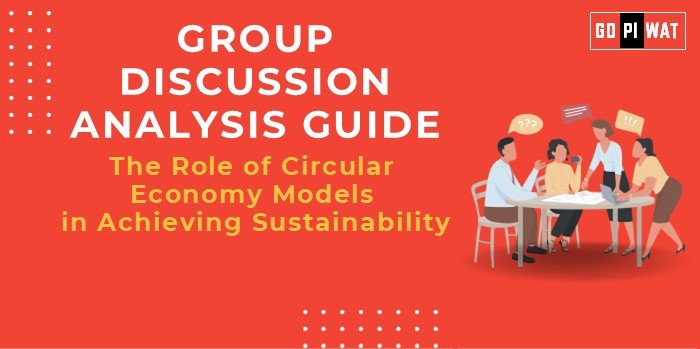📋 Group Discussion Analysis Guide
The Role of Circular Economy Models in Achieving Sustainability
🌍 Introduction to the Topic
- 🌐 Opening Context: The transition to circular economy models has gained momentum globally as businesses and governments seek sustainable solutions to resource management.
- 📖 Topic Background: Originating from principles of reuse, remanufacturing, and recycling, the circular economy aims to minimize waste and environmental impact. Notable examples include the European Union’s Circular Economy Action Plan and China’s circular manufacturing policies.
📊 Quick Facts and Key Statistics
- ♻️ Global Waste Generated: 2.2 billion tons annually (2023) – highlights the urgency of waste reduction.
- 🔄 Recycling Rate in Manufacturing: Only 9% of materials are recycled globally.
- 💰 Economic Potential: $4.5 trillion economic benefits by 2030 (Ellen MacArthur Foundation).
- ⚡ Energy Savings: Circular models can reduce energy consumption by up to 60% in certain industries.
- 🌍 Policy Adoption: Over 25 countries have adopted circular economy frameworks.
🌱 Stakeholders and Their Roles
- 🏛️ Governments: Regulate and incentivize sustainable practices through policies and subsidies.
- 🏭 Manufacturers: Adopt waste-reducing production processes and design recyclable products.
- 👥 Consumers: Demand eco-friendly products and practice responsible consumption.
- 🌐 NGOs and International Organizations: Promote awareness and support circular initiatives globally.
🏆 Achievements and Challenges
Achievements:
- 🌟 Material Reuse: Companies like Renault save 85% energy by using recycled parts in cars.
- 📈 Economic Growth: Countries like the Netherlands lead, with 24% of materials recycled in manufacturing.
- 🌍 Carbon Footprint Reduction: Circular models in cement production cut emissions by 30%.
- 👷 Increased Employment: Jobs in recycling and remanufacturing industries are growing globally.
Challenges:
- 💸 High Initial Investment: Transitioning requires costly technology upgrades.
- ⚖️ Consumer Behavior: Low awareness and preference for disposable goods.
- 🌐 Policy Gaps: Inconsistent global standards hinder cross-border initiatives.
📖 Global Comparisons:
- 🇪🇺 EU Success: EU nations recycle 56% of their waste, setting benchmarks.
- 🌍 Developing Nations: Limited adoption due to infrastructure and financial constraints.
📖 Case Studies:
- 🇮🇳 India: Recycling initiatives in e-waste management increased material recovery by 15% since 2020.
- 🇩🇰 Denmark: Circular design in textiles reduced landfill waste by 20%.
💬 Structured Arguments for Discussion
- ✅ Supporting Stance: “Circular economy models significantly cut manufacturing waste and promote resource efficiency, as seen in the EU’s success.”
- ❌ Opposing Stance: “Adoption is slow in developing countries due to high costs and insufficient infrastructure.”
- ⚖️ Balanced Perspective: “While circular models are promising, widespread adoption requires global cooperation and funding.”
🗣️ Effective Discussion Approaches
Opening Approaches:
- 🌟 Highlight the economic and environmental urgency of transitioning to circular models.
- 📖 Use a global success story like the EU’s Action Plan.
- ⚖️ Present a counterpoint on challenges in implementation.
Counter-Argument Handling:
- 💡 Acknowledge barriers like costs but suggest solutions such as subsidies.
- 📈 Highlight successful cases proving feasibility in developing nations.
📊 Strategic Analysis of Strengths and Weaknesses
- 💪 Strengths: Reduced environmental impact, economic benefits, energy efficiency.
- ❌ Weaknesses: Implementation cost, lack of global standards.
- 🌟 Opportunities: Innovation in eco-design, global partnerships.
- ⚠️ Threats: Resistance to change, resource scarcity.
🎓 Connecting with B-School Applications
- 🌐 Real-World Applications: Sustainability strategies for operations and supply chain projects.
- 🎯 Sample Interview Questions:
- “How can circular models reshape the manufacturing sector?”
- “What role does policy play in enabling a circular economy?”
- 📘 Insights for Students: Importance of sustainability in business strategy and future leadership roles.


